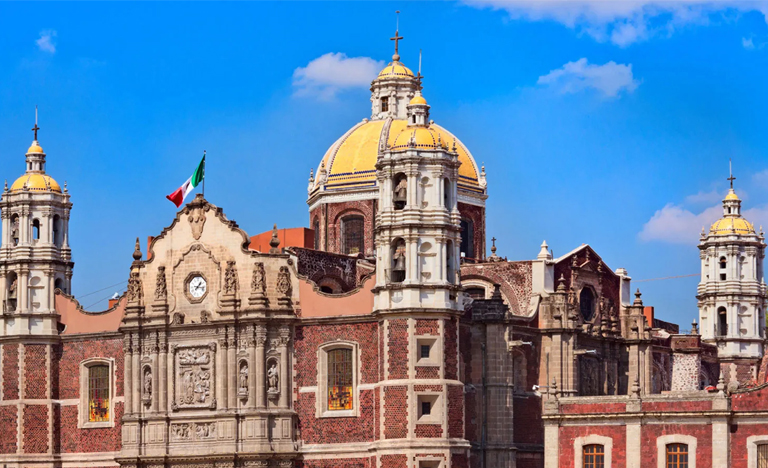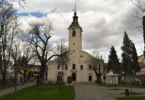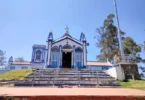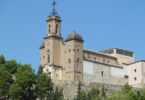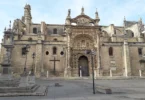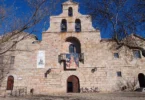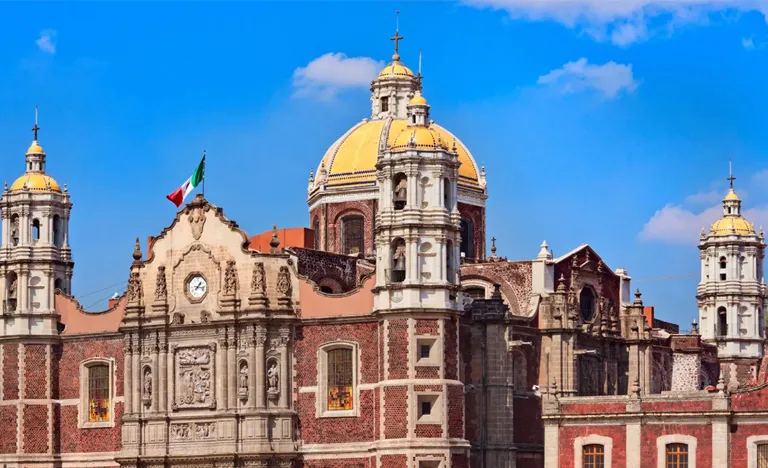
Introduction
The Basilica of Our Lady of Guadalupe, Mexico is a Catholic church, basilica, and National shrine of Mexico which houses the cloak containing the image of Our Lady of Guadalupe. In 1709 shrine was built in the North of Mexico City near the hill of Tepeyac, where the Virgin Mary is believed to have appeared to Saint Juan Diego Cuauhtlatoatzin. The basilica structure which now contains Juan Diego’s cloak was completed in 1974.
The Basilica of Our Lady of Guadalupe, Mexico is also known as La Villa de Guadalupe, in a more popular sense, La Villa, and has several churches and related buildings.
One of the most important pilgrimage sites of Christianity, the basilica and tilma (cloak) are visited by several million people every year, especially around 12 December, Our Lady of Guadalupe’s Feast day.
History of Basilica of Our Lady of Guadalupe, Mexico
A nearby chapel was built on the sacred site devoted to a temple for Tonantzin Coatlaxopeuh, an important mother goddess, after the Spanish conquerors destroyed the temple. Pilgrimages have been made to this shrine almost uninterrupted since 1531 & 1532. In the latter year, a shrine had been constructed at the foot of Tepeyac Hill, which served the people for ninety years. It was adapted as part of the parochial sacristy of the new basilica. In 1622 a rich shrine was erected; a newer one, much richer, in 1709.
Other structures of the eighteenth century connected with it are a parish church, a convent and church for Capuchin nuns, a well chapel, and a hill chapel. About 1750 the shrine got the title of collegiate, and a canonry and choir service were established. In 1754 it was aggregated to the Basilica of St. John Lateran. In 1904 it was designated as a basilica.
Old Basilica
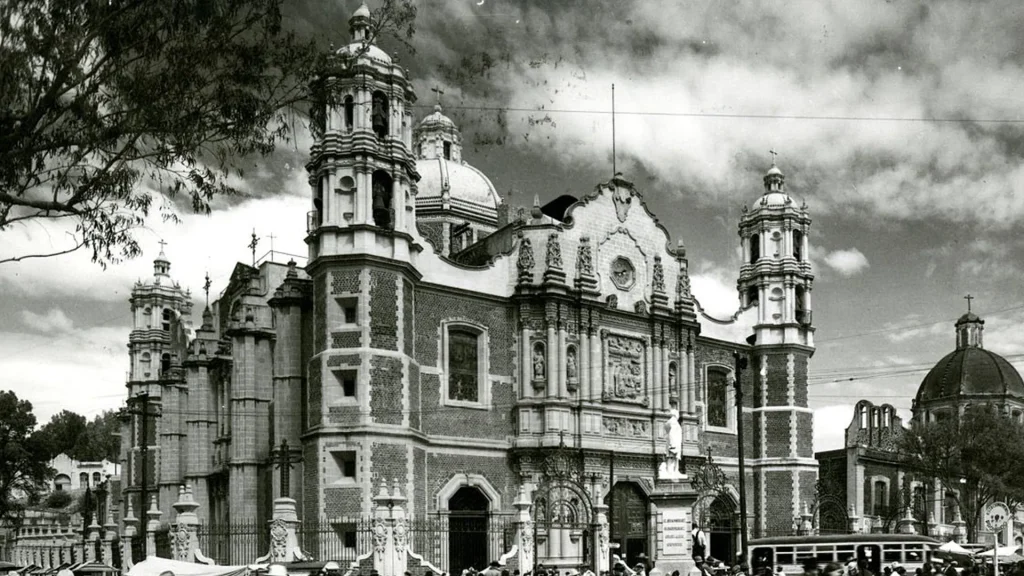
The Basilica of Our Lady of Guadalupe, Mexico officially known as the “Templo Expiatorio a Cristo Rey,” the first structure of the old basilica was begun in 1695 and it was not finished until 1709. The major architect was Pedro de Arrieta. It is characterized by its doric interior and marble statues of Fray Juan de Zumárraga, archbishop at the time it was started, and Juan Diego, the peasant who saw the vision of the Virgin Mary.
These are featured in the altarpiece that originally held the image of Our Lady of Guadalupe. (That altarpiece matches a similar one in the older chapel higher on the hill, which features the archangels Gabriel and Michael). The church was granted basilica status by Pope Pius X in 1904. The icon of Juan Diego’s cloak was housed in this church from 1709 to 1974.
In 1921 a bomb planted in a flower vase near the altar by an anticlerical terrorist exploded, causing great damage to the interior of the building. (In memory of this incident, the New Basilica displays an iron crucifix called “the attempt on Christ”.) The cloak survived undamaged.
As much of Mexico City is built upon the dried lakebed of Lake Texcoco, the land was unstable and the old basilica was sinking. A new, more spacious basilica was built. The old one was closed for many years and repairs have recently finished. It is open to the public and perpetual adoration is held there.
Modern Basilica
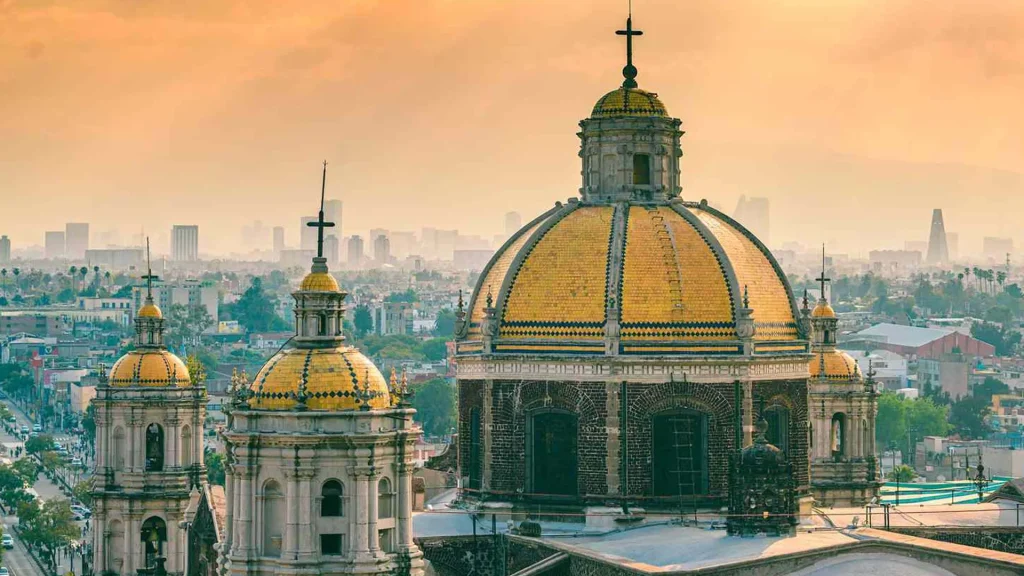
The present church was constructed on the site of an earlier 16th century church that was finished in 1709, the Old Basilica. When this basilica became dangerous due to the sinking of its foundations, a modern structure called the New Basilica was built next to it; the original image of the Virgin of Guadalupe is now housed in this New Basilica. Built between 1974 and 1976, the new Basilica has a circular floor plan so that the image of the Virgin can be seen from any point within the building.
The circular structure is 100 meters (330 feet) in diameter and can accommodate up to 10,000 people. The choir is located between the altar and the churchgoers to indicate that it, too, is part of the group of the faithful. To the sides are the chapels of the Santisimo and of Saint Joseph. It has 9 chapels on the upper floor. Under the main floor are the Basilica’s crypts, with 15,000 niches and 10 chapels. Its seven front doors are an allusion to the seven gates of Celestial Jerusalem referred to by Christ.
In the Sanctuary grounds where the new Basilica is located there are also many other buildings, including the original chapel on the exact site of the apparitions to Juan Diego (Capilla del Cerrito) and the Old Basilica consecrated in 1709, as well as other chapels where Masses and other sacraments of the Church are celebrated daily.
Our Lady of Guadalupe

Our Lady of Guadalupe, also known as the Virgin of Guadalupe is a Catholic title of Mary, mother of Jesus associated with a series of five Marian apparitions, which are believed to have occurred in December 1531, and a venerated image on a cloak enshrined within the Basilica of Our Lady of Guadalupe in Mexico City. The basilica is the most-visited Catholic shrine in the world, and the world’s third most-visited sacred site.
Pope Leo XIII granted the image a decree of canonical coronation on 8 February 1887 and was pontifically crowned on 12 October 1895.
Marian Apparitions
According to Nican Mopohua, a 17th-century account written in the native Nahuatl language, the Virgin Mary appeared four times to Juan Diego, an indigenous Mexican peasant Chichimec and once to his uncle, Juan Bernardino. The first apparition occurred on the morning of Saturday, 9 December 1531 (Julian calendar, which is December 19 on the (proleptic) Gregorian calendar in present use). Juan Diego experienced a vision of a young woman at a place called the Hill of Tepeyac, which later became part of Villa de Guadalupe, in a suburb of Mexico City.
According to the accounts, the woman, speaking to Juan Diego in his native Nahuatl language (the language of the Aztec Empire), identified herself as the Virgin Mary, “mother of the very true deity”. She was said to have asked for a church to be erected at that site in her honor. Based on her words, Juan Diego then sought the Archbishop of Mexico City, Fray Juan de Zumárraga, to tell him what had happened. Not unexpectedly, the Archbishop did not believe Diego. Later the same day, Juan Diego again saw the young woman (the second apparition), and she asked him to continue insisting.
The next day, Sunday, December 10, 1531 (Julian calendar), Juan Diego spoke to the Archbishop a second time. The latter instructed him to return to Tepeyac Hill and to ask the woman for a truly acceptable, miraculous sign to prove her identity. Later that day, the third apparition appeared when Juan Diego returned to Tepeyac; encountering the same woman, he reported to her the Archbishop’s request for a sign, which she consented to provide on the next day (December 11).
By Monday, December 11 (Julian calendar), however, Juan Diego’s uncle, Juan Bernardino, became ill, which obligated Juan Diego to attend to him. In the very early hours of Tuesday, December 12 (Julian calendar), Juan Bernardino’s condition having deteriorated overnight, Juan Diego journeyed to Tlatelolco to get a Catholic priest to hear Juan Bernardino’s confession and help minister to him on his deathbed.
To avoid being delayed by the Virgin and ashamed at having failed to meet her on Monday as agreed, Juan Diego chose another route around Tepeyac Hill, yet the Virgin intercepted him and asked where he was going (fourth apparition); Juan Diego explained what had happened and the Virgin gently chided him for not having made recourse to her.
In the words which have become the most famous phrase of the Guadalupe apparitions and are inscribed above the main entrance to the Basilica of Guadalupe, she asked “Am I not here, I who am your mother?”. She assured him that Juan Bernardino had now recovered and told him to gather flowers from the summit of Tepeyac Hill, which was normally barren, especially in the cold of December. Juan Diego obeyed her instruction and he found Castilian roses, not native to Mexico, blooming there.
According to the story, the Virgin arranged the flowers in Juan Diego’s tilma, or cloak, and when Juan Diego opened his cloak later that day before Archbishop Zumárraga, the flowers fell to the floor, revealing on the fabric the image of the Virgin of Guadalupe.
The next day, December 13 (Julian calendar), Juan Diego found his uncle fully recovered as the Virgin had assured him, and Juan Bernardino recounted that he also had seen her after praying at his bedside (fifth apparition); that she had instructed him to inform the Archbishop of this apparition and of his miraculous cure; and that she had told him she desired to be known under the title of ‘Guadalupe’.
The Archbishop kept Juan Diego’s mantle, first in his private chapel and then in the church on public display, where it attracted great attention. On December 26, 1531, a procession formed to transfer the miraculous image back to Tepeyac Hill where it was installed in a small, hastily erected chapel.
During this procession, the first miracle was allegedly performed when a native was mortally wounded in the neck by an arrow shot by accident during some stylized martial displays performed in honor of the Virgin. In great distress, the natives carried him before the Virgin’s image and pleaded for his life. Upon the arrow being withdrawn, the victim fully and immediately recovered.
Origin in Guadalupe, Spain
The shrine to Our Lady of Guadalupe in Guadalupe, Cáceres, in Extremadura, Spain was the most important Marian shrine in the medieval kingdom of Castile. It is one of the many dark or black skinned Madonnas in Spain and is revered in the Monastery of Santa María de Guadalupe, in the town of Guadalupe, from which numerous Spanish conquistadors stem. The name is believed to be derived from the Arabic phrase “Wad-al-lubb” (“hidden river”), because the river narrows down as it flows near to the town of Guadalupe.
The shrine houses a statue reputed to have been carved by Luke the Evangelist and given to Leander of Seville, archbishop of Seville, by Pope Gregory I. According to local legend, when Seville was taken by the Moors in 712, a group of priests fled northward and buried the statue in the hills near the Guadalupe River.
At the beginning of the 14th century, the Virgin appeared one day to a humble cowboy named Gil Cordero who was searching for a missing animal in the mountains. Cordero claimed that the Virgin Mary had appeared to him and ordered him to ask priests to dig at the site of the apparition. Excavating priests rediscovered the hidden statue and built a small shrine around it which became the great Guadalupe monastery.
Origin in Mexico
Following the Conquest in 1519 to 1521, the Marian cult was brought to the Americas and Franciscan friars often leveraged syncretism with existing religious beliefs as an instrument for evangelization. What is purported by some to be the earliest mention of the miraculous apparition of the Virgin is a page of parchment, the Codex Escalada from 1548, which was discovered in 1995 and, according to investigative analysis, dates from the sixteenth century.
This document bears two pictorial representations of Juan Diego and the apparition, several inscriptions in Nahuatl referring to Juan Diego by his Aztec name, and the date of his death: 1548, as well as the year that the then named Virgin Mary appeared: 1531. It also contains the glyph of Antonio Valeriano; and finally, the signature of Fray Bernardino de Sahagun which was authenticated by experts from the Banco de Mexico and Charles E. Dibble. Scholarly doubts have been cast on the authenticity of the document.
A more complete early description of the apparition occurs in a 16 page manuscript called the Nican mopohua, which has been reliably dated in 1556 and was acquired by the New York Public Library in 1880. This document, written in Nahuatl, but in Latin script, tells the story of the apparitions and the supernatural origin of the image. It was probably composed by a native Aztec man, Antonio Valeriano, who had been educated by Franciscans. The text of this document was later incorporated into a printed pamphlet which was widely circulated in 1649.
In spite of these documents, there are no 16th century written accounts of the Guadalupe vision by the archbishop Juan de Zumárraga, as there ought to have been, if the event had the Christian importance it is said to have had. In particular, the canonical account of the vision features archbishop Juan de Zumárraga as a major player in the story, but, although Zumárraga was a prolific writer, there is nothing in his extant writings that can confirm the indigenous story.
The written record suggests the Catholic clergy in 16th century Mexico were deeply divided as to the orthodoxy of the native beliefs springing up around the image of Our Lady of Guadalupe, with the Franciscan order (who then had custody of the chapel at Tepeyac) being strongly opposed to the outside groups, while the Dominicans supported it.
The main promoter of the story was the Dominican Alonso de Montúfar, who succeeded the Franciscan Juan de Zumárraga as archbishop of Mexico. In a 1556 sermon Montúfar commended popular devotion to “Our Lady of Guadalupe”, referring to a painting on cloth (the tilma) in the chapel of the Virgin Mary at Tepeyac, where certain miracles had also occurred. Days later, Fray Francisco de Bustamante, local head of the Franciscan order, delivered a sermon denouncing the native belief and believers. He expressed concern that the Catholic Archbishop was promoting a superstitious regard for an indigenous image.
The devotion at the chapel to which they have given the name Guadalupe was prejudicial to the Indians because they believed that the image itself worked miracles, contrary to what the missionary friars had been teaching them, and because many were disappointed when it did not.
Archbishop Montúfar opened an inquiry into the matter at which the Franciscans repeated their position that the image encouraged idolatry and superstition, and four witnesses testified to Bustamante’s statement that the image was painted by an Indian, with one witness naming him “the Indian painter Marcos”. This could refer to the Aztec painter Marcos Cipac de Aquino, who was active at that time.
Prof. Jody Brant Smith, referring to Philip Serna Callahan’s examination of the tilma using infrared photography in 1979, wrote “if Marcos did, he apparently did so without making a preliminary sketches in itself then seen as a near miraculous procedure. Cipac may well have had a hand in painting the Image, but only in painting the additions, such as the angel and moon at the Virgin’s feet”.
Ultimately Archbishop Montúfar, himself a Dominican, decided to end Franciscan custody of the shrine. From then on the shrine was kept and served by diocesan priests under the authority of the archbishop. Moreover, Archbishop Montúfar authorized the construction of a much larger church at Tepeyac, in which the tilma was later mounted and displayed.
In the late 1570s, the Franciscan historian Bernardino de Sahagún denounced the cult at Tepeyac and the use of the name “Tonantzin” or to call her Our Lady in a personal digression in his General History of the Things of New Spain, also known as the “Florentine Codex”.
At this place [Tepeyac], [the Indians] had a temple dedicated to the mother of the gods, whom they called Tonantzin, which means Our Mother. There they performed many sacrifices in honor of this goddess. And now that a church of Our Lady of Guadalupe is built there, they also called her Tonantzin, being motivated by those preachers who called Our Lady, the Mother of God, Tonantzin.
While it is not known for certain where the beginning of Tonantzin may have originated, but this we know for certain, that, from its first usage, the word refers to the ancient Tonantzin. And it was viewed as something that should be remedied, for their having name of the Mother of God, Holy Mary, instead of Tonantzin, but Dios inantzin. It appears to be a Satanic invention to cloak idolatry under the confusion of this name, Tonantzin.
And they now come to visit from very far away, as far away as before, which is also suspicious, because everywhere there are many churches of Our Lady and they do not go to them. They come from distant lands to this Tonantzin as in olden times. Sahagún’s criticism of the indigenous group seems to have stemmed primarily from his concern about a syncretistic application of the native name Tonantzin to the Catholic Virgin Mary. However, Sahagún often used the same name in his sermons as late as the 1560s.
The Crown Ornament
The image had originally featured a 12 point crown on the Virgin’s head, but this disappeared in 1887. The change was first noticed on February 23, 1888, when the image was removed to a nearby church. Eventually a painter confessed on his deathbed that he had been instructed by a clergyman to remove the crown. This may have been motivated by the fact that the gold paint was flaking off of the crown, leaving it looking dilapidated.
But according to the historian David Brading, “the decision to remove rather than replace the crown was no doubt inspired by a desire to ‘modernize’ the image and reinforce its similarity to the nineteenth-century images of the Immaculate Conception which were exhibited at Lourdes and elsewhere… What is rarely mentioned is that the frame which surrounded the canvas was adjusted to leave almost no space above the Virgin’s head, thereby obscuring the effects of the erasure.”
A different crown was installed to the image. On February 8, 1887, a Papal bull from Pope Leo XIII granted permission a Canonical Coronation of the image, which occurred on October 12, 1895. Since then the Virgin of Guadalupe has been proclaimed “Queen of Mexico”, “Patroness of the Americas”, “Empress of Latin America”, and “Protectress of Unborn Children” (the latter two titles given by Pope John Paul II in 1999).
The Beatification of Juan Diego
Under Pope John Paul II the move to beatify Juan Diego intensified. John Paul II took a special interest in non-European Catholics and saints. During his leadership, the Congregation for the Causes of Saints declared Juan Diego “venerable” (in 1987), and the pope himself announced his beatification on May 6, 1990, during a Mass at the Basilica of Our Lady of Guadalupe in Mexico City, declaring him “protector and advocate of the indigenous peoples,” with December 9 established as his feast day.
At that time historians revived doubts as to the quality of the evidence regarding Juan Diego. The writings of bishop Zumárraga, into whose hands Juan purportedly delivered the miraculous image, did not refer to him or the event. The record of the 1556 ecclesiastical inquiry omitted him, and he was not mentioned in documentation before the mid-17th century.
In 1996 the 83-year-old abbot of the Basilica of Guadalupe, Guillermo Schulenburg, was forced to resign following an interview published in the Catholic magazine Ixthus, in which he was quoted as saying that Juan Diego was “a symbol, not a reality”, and that his canonization would be the “recognition of a cult. It is not recognition of the physical, real existence of a person.” In 1883 Joaquín García Icazbalceta, historian and biographer of Zumárraga, in a confidential report on the Lady of Guadalupe for Bishop Labastida, had been hesitant to support the story of the vision. He concluded that Juan Diego had not existed.
In 1995, Father Xavier Escalada, a Jesuit whose four volume Guadalupe encyclopedia had just been published, announced the existence of a sheet of parchment (known as Codex Escalada), which bore an illustrated account of the vision and some notations in Nahuatl concerning the life and death of Juan Diego.
Previously unknown, the document was dated 1548. It bore the signatures of Antonio Valeriano and Bernardino de Sahagún, which are considered to verify its contents. The codex was the subject of an appendix to the Guadalupe encyclopedia, published in 1997. Some scholars remained unconvinced, one describing the discovery of the Codex as “rather like finding a picture of St. Paul’s vision of Christ on the road to Damascus, drawn by St. Luke and signed by St. Peter.”
Marian Title - Virgin de Guadalupe
In the earliest account of the apparition, the Nican Mopohua, the Virgin de Guadalupe, later called as if the Virgin Mary tells Juan Bernardino, the uncle of Juan Diego, that the image left on the tilma is to be known by the name “the Perfect Virgin, Holy Mary of Guadalupe.” The Virgin of Guadalupe is a core element of Mexican identity and with the rise of Mexican nationalism and indigenist ideologies, there have been numerous efforts to find a pre-Hispanic origin in the cult, to the extreme of attempting to find a Nahuatl etymology to the name.
The first theory to promote a Nahuatl origin was that of Luis Becerra Tanco. In his 1675 work Felicidad de Mexico, Becerra Tanco said that Juan Bernardino and Juan Diego would not have been able to understand the name Guadalupe because the “d” and “g” sounds do not exist in Nahuatl.
He proposed two Nahuatl alternative names that sound similar to “Guadalupe”, Tecuatlanopeuh, which he translates as “she whose origins were in the rocky summit”, and Tecuantlaxopeuh, “she who banishes those who devoured us.”
Ondina and Justo González suggest that the name is a Spanish version of the Nahuatl term, Coātlaxopeuh, which they interpret as meaning “the one who crushes the serpent,” and that it may seem to be referring to the feathered serpent Quetzalcoatl. In addition, the Virgin Mary was portrayed in European art as crushing the serpent of the Garden of Eden.
According to another theory the juxtaposition of Guadalupe and a snake may indicate a nexus with the Aztec goddess of love and fertility, Tonantzin (in Nahuatl, “Our Revered Mother”), who was also known by the name Coatlícue (“The Serpent Skirt”).
This appears to be borne out by the fact that this goddess already had a temple dedicated to her on the very Tepeyac Hill where Juan Diego had his vision, the same temple which had recently been destroyed at the behest of the new Spanish Catholic authorities. In the 16th century the Franciscans were suspicious that the followers of Guadalupe showed, or was susceptible to, elements of syncretism, the importation of an object of reverence in one belief system into another.
The theory promoting the Spanish origin of the name says that: Juan Diego and Juan Bernardino would have been familiar with the Spanish “g” and “d” sounds since their baptismal names contain those sounds. There is no documentation of any other name for this Marian apparition during the almost 144 years between the apparition being recorded in 1531 and Becerra Tanco’s proposed theory in 1675.
Documents written by contemporary Spaniards and Franciscan friars argue that for the name to be changed to a native name, such as Tepeaca or Tepeaquilla, would not make sense to them, if a Nahuatl name were already in use, and suggest the Spanish Guadalupe was the original.
The Venerated Image as Artifact - Iconographic Description
- The image features a full-length representation of a girl or young woman, delicate features, and straight, unbraided hair simply parted in the middle framing her face.
- The subject matter is in a standing posture showing in contemplative prayer with hands joined and little finger separated and head slightly inclined; she gazes with heavy-lidded eyes at a spot below and to her right, and to left in viewpoint of the observer.
- She is dressed from neck to feet in a pink robe and blue-green cerulean mantle, one side folded within the arms, emblazoned with eight-pointed stars with two black tassels tied at high waist, wearing a neck brooch featuring a colonial styled cross.
- The robe is spangled with a small gold quatrefoil motif ornamented with vines and flowers, its sleeves reaching to her wrists where the cuffs of a white undergarment appear.
- The subject stands on a crescent moon, allegedly colored silver in the past, now having turned dark.
- A feathered cherubic angel with outstretched arms carries the robe on her exposed feet which is uncolored.
- A sunburst of straight and wavy gold rays alternate while projecting behind the Virgin and are enclosed within a mandorla. Beyond the mandorla to the right and left is an unpainted expanse, white in color with a faint blue tinge. The present image shows the 1791 nitric acid spill on the top right side, unaffecting the subject matter’s aureola.
Physical Description
The portrait was executed on a fabric support of natural material constituted by two pieces (originally three) joined. The join is clearly visible as a seam passing from top to bottom, with the Virgin’s face and hands and the head of the angel on the left piece. It passes through the left wrist of the Virgin. The fabric is mounted on a large metal sheet to which it has been glued for some time. The image, currently set in a massive frame protected behind bullet-proof glass, hangs inclined at a slight angle on the wall of the basilica behind the altar.
At this point, there is a wide gap between the wall and the sanctuary facilitating closer viewing from moving walkways set on the floor beneath the main level of the basilica, carrying people a short distance in either direction. Viewed from the main body of the basilica, the image is located above and to the right of the altar and is retracted at night into a small vault set into the wall.
An intricate metal crown designed by the painter Salomé Pina according to plans devised by Rómulo Escudero and Pérez Gallardo, and executed by the Parisian goldsmith, Edgar Morgan, is fixed above the image by a rod, and a massive Mexican flag is draped around and below the frame.
The nature of the fabric is discussed below. Its measurements were taken by José Ignacio Bartolache on December 29, 1786, in the presence of José Bernardo de Nava, a public notary: height 170 cm (67 inches), width 105 cm (41 inches). The original height (before it was first shielded behind glass in the late 18th century, at which time the unpainted portion beyond the Virgin’s head must have been cut down) was 229 cm (90 inches).
Trans-Religious Significance
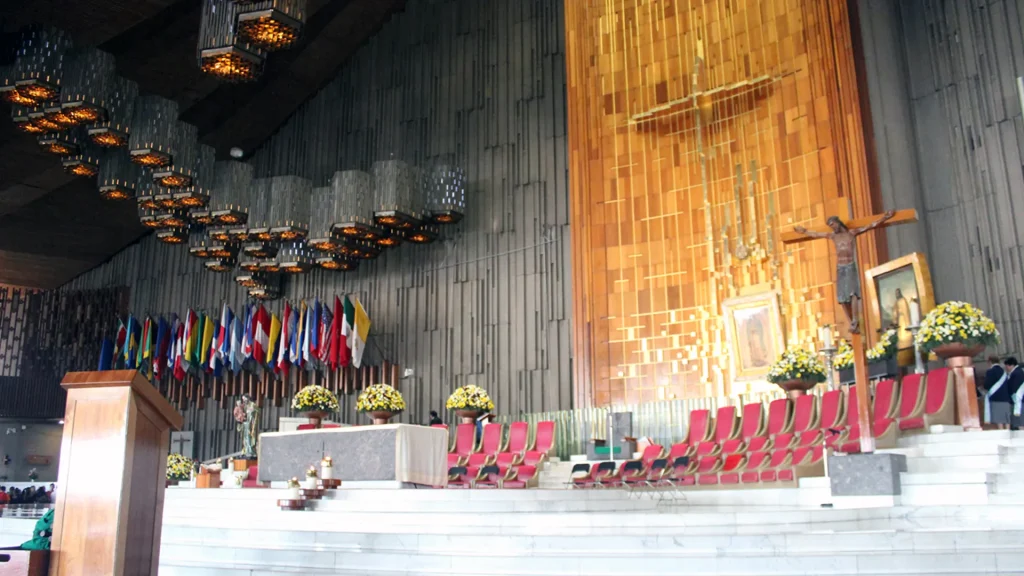
Religious imagery of Our Lady of Guadalupe appears in Roman Catholic parishes, especially those with Latin American heritage. In addition, due to the growth of Hispanic communities in the United States, religious imagery of Our Lady of Guadalupe has started appearing in some Anglican, Lutheran, and Methodist churches. Additionally, Our Lady of Guadalupe is venerated by some Mayan Orthodox Christians in Guatemala.
The iconography of the Virgin is fully Catholic: Miguel Sánchez, the author of the 1648 tract Imagen de la Virgen María, described her as the Woman of the Apocalypse from the New Testament’s Revelation, “clothed with the sun, and the moon under her feet, and upon her head a crown of twelve stars.” She is described as a representation of the Immaculate Conception.
Virgil Elizondo says the image also had layers of meaning for the indigenous people of Mexico who associated her image with their polytheistic deities, which further contributed to her popularity.
Her blue-green mantle was the color reserved for the divine couple Ometecuhtli and Omecihuatl; her belt is interpreted as a sign of pregnancy; and a cross-shaped image, symbolizing the cosmos and called nahui-ollin, is inscribed beneath the image’s sash. She was called “mother of maguey,” the source of the sacred beverage pulque. Pulque was also known as “the milk of the Virgin.” The rays of light surrounding her are seen to also represent maguey spines.
Cultural Significance
Juan Diego’s tilma has become Mexico’s most popular religious and cultural symbol, and has received widespread ecclesiastical and popular veneration. In the 19th century it became the rallying cry of the Spaniards born in America, in what they denominated ‘New Spain’. They said they considered the apparitions as legitimizing their own indigenous Mexican origin. They infused it with an almost messianic sense of mission and identity, thereby also justifying their armed rebellion against Spain.
Symbol of Mexico
Throughout the Mexican national history of the 19th and 20th centuries, the Guadalupan name and image have been unifying national symbols; the first President of Mexico (1824–1829) changed his name from José Miguel Ramón Adaucto Fernández y Félix to Guadalupe Victoria in honor of the Virgin of Guadalupe.
Father Miguel Hidalgo, in the Mexican War of Independence (1810), and Emiliano Zapata, in the Mexican Revolution (1910), led their respective armed forces with Guadalupan flags emblazoned with an image of Our Lady of Guadalupe. In 1999, the Church officially proclaimed her the Patroness of the Americas, the Empress of Latin America, and the Protectress of Unborn Children.
In 1810, Miguel Hidalgo y Costilla initiated the bid for Mexican independence with his Grito de Dolores, with the cry “Death to the Spaniards and long live the Virgin of Guadalupe!” When Hidalgo’s mestizo-indigenous army attacked Guanajuato and Valladolid, they placed “the image of the Virgin of Guadalupe, which was the insignia of their enterprise, on sticks or on reeds painted different colors” and “they all wore a print of the Virgin on their hats.”
After Hidalgo’s death, leadership of the revolution fell to a mestizo priest named José María Morelos, who led insurgent troops in the Mexican south. Morelos adopted the Virgin as the seal of his Congress of Chilpancingo, inscribing her feast day into the Chilpancingo constitution and declaring that Guadalupe was the power behind his victories.
New Spain puts less faith in its own efforts than in the power of God and the intercession of its Blessed Mother, who appeared within the precincts of Tepeyac as the miraculous image of Guadalupe that had come to comfort us, defend us, visibly be our protection.
Simón Bolívar noticed the Guadalupan theme in these uprisings, and shortly before Morelos’s execution in 1815 wrote “the leaders of the independence struggle have put fanaticism to use by proclaiming the famous Virgin of Guadalupe as the queen of the patriots, praying to her in times of hardship and displaying her on their flags, the veneration for this image in Mexico far exceeds the greatest reverence that the shrewdest prophet might inspire.”
In 1912, Emiliano Zapata’s peasant army rose out of the south against the government of Francisco Madero. Though Zapata’s rebel forces were primarily interested in land reform ‘land and liberty’ was the slogan of the uprising when his peasant troops penetrated Mexico City, they carried Guadalupan banners.
More recently, the contemporary Zapatista National Liberation Army (EZLN) named their “mobile city” in honor of the Virgin: it is called Guadalupe Tepeyac. EZLN spokesperson Subcomandante Marcos wrote a humorous letter in 1995 describing the EZLN bickering over what to do with a Guadalupe statue they had received as a gift.
Veneration
The shrine of the Virgin of Guadalupe is the most visited Catholic pilgrimage destination in the world. Over the Friday and Saturday of December 11 to 12, 2009, a record number of 6.1 million pilgrims visited the Basilica of Guadalupe in Mexico City to commemorate the anniversary of the apparition.
The Virgin of Guadalupe is considered the Patroness of Mexico and the Continental Americas; she is also venerated by Native Americans, on the account of the devotion calling for the conversion of the Americas. Replicas of the tilma can be found in thousands of churches throughout the world, and numerous parishes bear her name.
Due to Mary’s appearance as a pregnant mother and her claims as mother of all in the apparition, the Blessed Virgin Mary, under this title is popularly invoked as Patroness of the Unborn and a common image for the Pro-Life movement.
Feast Day - 12th December
Each December 12th, the Mexican Catholic community of Scott County celebrates the Feast Day of Our Lady of Guadalupe. This celebration commemorates the appearance of Mary to the Mexican peasant Juan Diego in 1531. The feast day is an important holiday in Mexico.
Mass Time
Every days
- 6:00 am
- 7:00 am
- 7:45 am
- 8:30 am
- 9:00 am
- 10:00 am
- 11:00 am
- 12:00 (Noon)
- 1:00 pm
- 2:00 pm
- 3:00 pm
- 4:00 pm
- 6:00 pm
- 7:00 pm
- 8:00 pm
Church Visiting Time
Every Days : 6:00 am to 9:00 pm
Contact Info
Basilica of Our Lady of Guadalupe,
Plaza de las Americas 1, Villa de Guadalupe,
Gustavo A. Madero, 07050 Mexico City, Federal District, Mexico
Phone No.
Tel : +52 55 5118 0500
Accomodation
How to reach the Basilica
Mexico City (MEX) Airport is the nearby airport to the Basilica.
La Villa-Basílica is Subway Station along Line 6 of the Mexico City Metro is the nearby Train Station to the Basilica.

